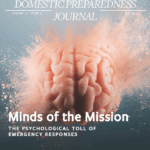When a wildfire, hurricane, tornado, or other event destroys a town, the response often includes community leaders. The Federal Emergency Management Agency (FEMA) considers disaster management as recurring events with four phases: mitigation, preparedness, response, and recovery. Depending on the source, prevention often appears as the fifth phase. Many, if not most, agencies spend less time on the mitigation and recovery phases unless they are part of a large emergency management organization with specialized departments. Since mitigation efforts would likely lessen the impact during recovery efforts, it is important to highlight the value of spending time and resources on the mitigation phase.
Although the collective resilience concept is not a normal part of an emergency management process or organizational structure, it could help lessen the effects after an emergency. One definition describes it as the ability of a group of people to adapt to, respond to, and collectively cope with crises. Another refers to it as the influence of existing social bonds.
Implementing the concept should be easily understood by those who adopted FEMA’s whole-community approach. Being familiar with the strengths, weaknesses, and abilities of the different community segments facilitates the execution of the emergency management phases.
While grassroots efforts often exemplify this concept, emergency managers and other community leaders can use it to ensure recovery plans include guidance for specific outreach activities such as holding vigils, appreciation events for responders, and productive direction of volunteer forces and donations.
What Does Collective Resilience Look Like?
The answer to this question is different for each crisis. For Las Vegas, it was the construction of the Las Vegas Healing Garden to commemorate the lives lost during the Route 91 Harvest Festival. For Boston, it was the simple yet effective slogan “Boston Strong” in the wake of the Boston Marathon Bombing. While these examples are significant, such efforts should be formulated and implemented before a catastrophic event.
Trends in public stigma related to mental healthcare and emotional well-being have dramatically shifted over the past 20 years. Regarding disaster recovery, it is critical to consider the “whole person.”
Implementing a collective resilience approach starts with executive leadership. Allocating valuable time and resources to something that may or may not happen is typically further down on the priority list of critical response needs. Collective resilience can quickly become a slogan or simply words on paper without executive support.
The conditions that influenced the psychological dimension of collective resilience include:
- The action of subjects, such as the government, corporations, social organizations, and the public;
- Their behavioral characteristics, such as institutional strengths, coordination of collective resource allocation, and collective cognition; and
- The resulting spiritual connotations, such as spiritual identity, collective memory, identification with hero figures, and collectivist value.
Although it must have executive support and be practiced at all organizational levels, collective resilience should be an active process at the smallest level within an organization. The commitment to collective resilience should be demonstrated by the “boots on the ground,” whether that is a volunteer cadre, patrol officers, or administrative personnel manning a disaster recovery call center. Seeing positive results from the implementation of collective resilience principles has a “trickle-up” effect, where midlevel management and executive leadership see the psychological and emotional recovery taking place in real time, even when the physical recovery may appear to be stalled.
Despite limited research on the overall concept and its benefits, there is even less information about how to implement such a program through executive support, leadership, and creativity. Organizations that adhere to the benefits of teamwork, collaboration, and camaraderie (or esprit de corps) are headed in the right direction.
Specific ways to build and maintain collective resilience within an organization depend on the creativity and needs of the organization. Examples include:
- Members of groups that demonstrate effective teamwork tend to be more productive and care for each other.
- Human characteristics, such as empathy, self-value, humility, and trust, may enhance closeness within groups and among individuals.
- Although people value their free time, organizations that build in social events during the workday will likely get to know and value their co-workers more.
- Family events offer another way to unite people if planned in a manner that does not become a “command performance” event where people are forced to have fun.
Use traditional and outside-the-box thinking to find ways to bring a collective resilience focus to the organization and incorporate, for example:
- Community Emergency Response Teams (CERT),
- New employee orientation at the organizational and departmental levels,
- Neighborhood and community associations, and
- Happy hours (which do not have to be drinking events) or any other well-planned social event designed to bring the community together.
It is worth noting that a poorly planned or self-serving event could have the opposite effect. For example, a social event on a Saturday night could take away valuable personal time and disrupt the work-home balance.
Taking a New Approach
Many people have heard and have said, “I couldn’t have done it without you.” This kind of thinking should be the desired goal. Establishing a “couldn’t have … without you” mentality helps build community relationships that greatly benefit those in need after a critical event. The concept of collective resilience is not part of the typical emergency preparedness strategy, but it can be woven into all phases of emergency management. It just takes creative thinking and research to develop a realistic program. Devoting a little more time and effort to building such teams and finding specific ways to mitigate the effects of an emergency can build stronger communities that are more prepared to face any future threat or hazard.

Andrew (Andy) Altizer
Andrew (Andy) Altizer has over 20 years of emergency management planning experience and another 10 years of planning experience in the military. He is the emergency preparedness coordinator for The Westminster Schools and a Criminal Justice instructor at Georgia State University. Previously, he was the director of emergency management at Kennesaw State University and director of emergency preparedness at Georgia Institute of Technology. He also served as the critical infrastructure protection program manager at the Georgia Office of Homeland Security. In the U.S. Army, his roles included inspector general, public affairs officer, artillery commander, and plans and operations officer.
- Andrew (Andy) Altizerhttps://www.domprep.com/author/andrew-andy-altizer
- Andrew (Andy) Altizerhttps://www.domprep.com/author/andrew-andy-altizer
- Andrew (Andy) Altizerhttps://www.domprep.com/author/andrew-andy-altizer
- Andrew (Andy) Altizerhttps://www.domprep.com/author/andrew-andy-altizer

Barrett Cappetto
Barrett Cappetto is a pipeline controller with Colonial Pipeline Company and is responsible for coordinating control center security and operational readiness. Previously, he served in emergency management and law enforcement roles within the University System of Georgia institutions. He is a graduate of Georgia Highlands College Bachelor of Science in Criminal Justice and is an alumnus of FEMA’s Emergency Management Basic Academy.
- Barrett Cappettohttps://www.domprep.com/author/barrett-cappetto
- Barrett Cappettohttps://www.domprep.com/author/barrett-cappetto
- Barrett Cappettohttps://www.domprep.com/author/barrett-cappetto
- Barrett Cappettohttps://www.domprep.com/author/barrett-cappetto






